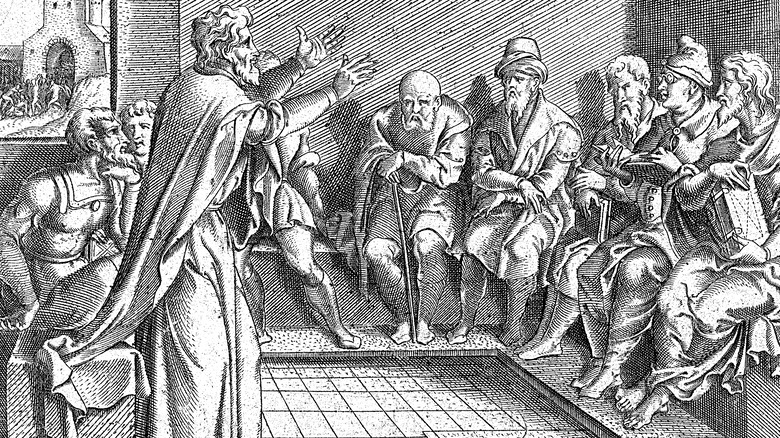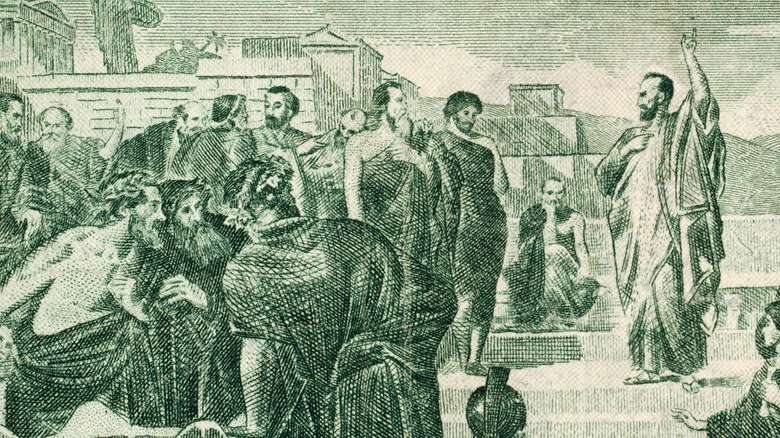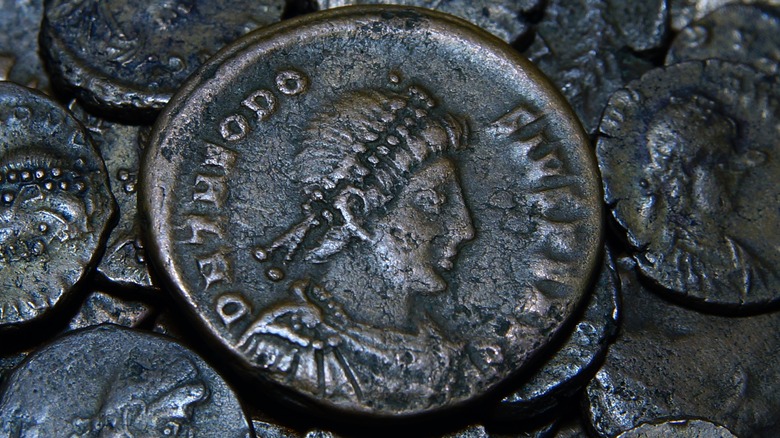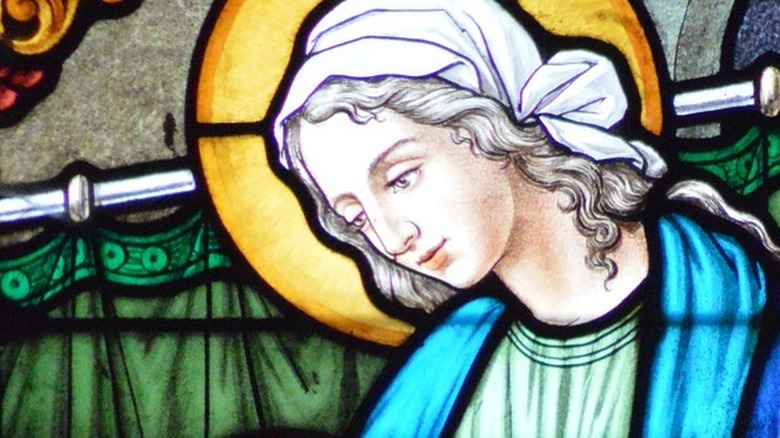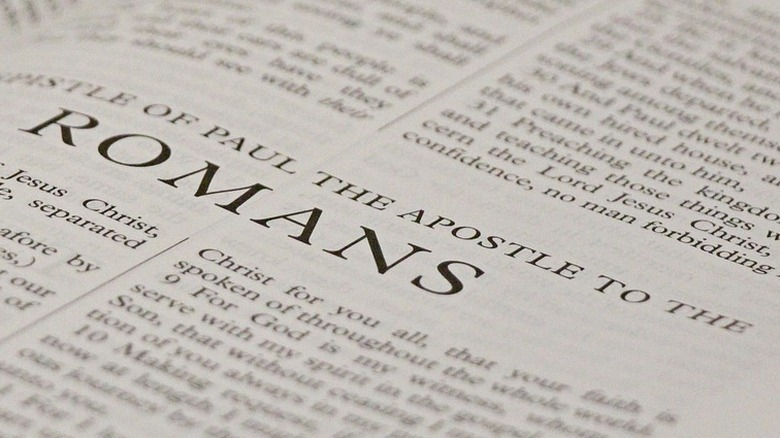The Untold Truth Of The Epistle To The Romans
The Epistle to the Romans, named for the church to which it was addressed, was among the most impactful writings the Apostle Paul ever produced. This text has been regularly cited throughout history as the textual basis for much of modern Christianity's central doctrine, as well as the justification for its most brutal and exclusionary practices (per "Homosexuality and the Church").
Most historians agree that Paul wrote the Epistle to the Romans while residing in Corinth sometime around A.D. 57 (via Encyclopedia Britannica). At the time of its writing, Paul had spent the 10 previous years doing missionary work abroad, founding or visiting a multitude of churches — although Rome was not, in fact, one of them (via "Historical Context for Romans by Paul" and Encyclopedia Britannica).
Epistles, which make up a significant portion of the New Testament, were a common form of literature in the Hellenistic and even early Egyptian eras. They differed from letters in that they were generally a semi-formal medium of correspondence, addressed to a group of people rather than an individual (via Oxford Bibliographies). The Epistle to the Romans is now the sixth book in the canonical New Testament. Its history is as complex as its content.
Paul didn't actually know the Romans
Most of Paul's epistles were written to provide guidance to churches he had either founded or preached at while on his missions, but, oddly, Paul had never visited Rome and held no formal standing with the church. As he writes in Romans 15:22, "I was hindered these many times from coming to you," and in Romans 1:11, "For I long to see you, that I may impart unto you some spiritual gift."
Nonetheless, in Chapter 16 of Romans, Paul greets 28 people by name — several of whom were women. Based on the familiar tone with which he addresses these acquaintances, Paul had most likely met them before on a mission or in Jerusalem. Writing a letter to a group of people he had never met was unusual, but it's assumed Paul at least had a tertiary relationship with the community in that region, even if — despite what the tone of his letter might imply — it was a church over which he had zero authority.
Some speculate the Epistle to the Romans was an "ambassadorial letter" by way of introduction (via "Antioch and Rome"), which could also explain the letter's overly-formal tone in contrast with the other epistles he wrote. Paul, who was in Corinth at the time of the Epistle's writing, did eventually visit the Roman church in person around 60 A.D., when he presumably met the letter's recipients and most likely died there shortly after (via BBC News).
The letter may have been an attempt to solicit donations
Some theorized Paul wrote to the church in Rome in anticipation of collecting donations for his upcoming mission to Spain. Paul, in the words of Robert Paul Seesengood in "A Brief History," "implicitly" requests donations in Romans 15:24: "Whensoever I go unto Spain (for I hope to see you in my journey, and to be brought on my way thitherward by you, if first in some measure I shall have been satisfied with your company) ... For it hath been the good pleasure of Macedonia and Achaia to make a certain contribution for the poor among the saints that are at Jerusalem."
Collecting donations was not uncommon, and there is evidence that Paul at times relied on charity and financial gifts to fund his lengthy mission trips (Encyclopedia Britannica). It's unclear whether or not Paul received those donations, but the text of the Muratorian Fragment suggests he did eventually complete his mission to Spain and stop in Rome as promised.
Romans suggests women may have had power in the church
Of the 28 people Paul greets by name in Chapter 16 of the Epistle to the Romans, seven or eight of them seem to be women. One, Phoebe, is referred to as "a deacon in the church at Cenchreae," causing many to speculate women may have held positions of authority in the early church.
In Romans 16:3, Paul refers to Priscilla and Aquila as his "fellow workers." Paul also uses this term to refer to Timothy and Luke (via "Who Was Phoebe? Translating Diakonos in Romans 16:1"), presumably referring to their spiritual work, causing some to speculate Priscilla and Aquila may have helped Paul with his mission in Ephesus. This could imply that women may have held more influential positions in ministry than previously thought. He refers to multiple women by name, followed by the compliment that they have "worked very hard," which could mean any number of things while implying their role was at least impactful.
Paul might have been trying to expand his authority
Since Paul held no authority in the church in Rome, many are puzzled by why he felt the need to write the Epistle. One theory is that Paul was trying to expand his apostolic authority by establishing himself as a spiritual leader or moral authority. Paul, although a controversial figure in the early church, did hold a position of great standing after completing 10 years of missionary work and making a name for himself with his teachings. The Epistle to the Romans may have been an attempt to summarize his beliefs — particularly regarding the topic of Jewish inheritance and the Gentiles' relationship with the Old Testament law — in order to curry respect among members of the capital city (via "The Expository Times").
Unlike the former disciples, who were appointed by Jesus of Nazareth, Paul identifies himself as the "apostle to the Gentiles" and claims he has been personally deputized by God (via "The Source and Scope of Paul's Apostolic Authority"). As the rise of formal church hierarchy had yet to emerge, Paul may have been seeking to establish his role as a leader in the church overall, rather than just the churches he had founded (via "Paul and Power").
Romans 1 may not have been about homosexuality
The first chapter of Romans (Romans 1) is famous for its vehement rhetoric condemning homosexuality (and any sexual desire at all). Paul, who does not reference the teachings of Jesus of Nazareth but claims to convey the truth God has revealed to him personally, scolds the Roman church and speaks with fiery rhetoric about the sins of sexual desire and same-sex activity. This is the common interpretation, anyway.
Since constructions of gender and sexuality were drastically different in first-century Rome and first-century Jerusalem, some scholars have urged readers to adopt a holistic approach to the interpretation of the passage. Although Paul's beliefs are unmistakably negative, theories abound on the context and his intent, leading to a plethora of interpretations of this passage.
Theories abound. Preston Sprinkle suggests Paul may have been referring to a specific homoerotic trend at the time. James B. DeYoung theorizes that Paul condemns heterosexuals — not "natural" homosexuals" — who engage in "homosexual acts." Robin Scroggs suggests Paul was referring to pederasty, arguing that our modern concept of homosexuality did not exist in Greco-Roman times. In an altogether different vein, Jeramy Townsley claims the passage is a condemnation of polytheistic religions and goddess cults, arguing Romans 1 is not actually about homosexuality at all.
Who knows? The minutiae of these disagreements have had a tremendous impact on the laws of the church and on the course of our history.
